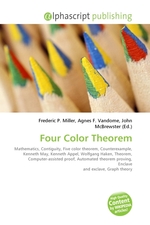Four Color Theorem
Frederic P. Miller, Agnes F. Vandome, John McBrewster
бумажная книга
In mathematics, the four color theorem, or the four color map theorem, states that given any separation of a plane into contiguous regions, called a map, the regions can be colored using at most four colors so that no two adjacent regions have the same color. Two regions are called adjacent only if they share a border segment, not just a point. Three colors are adequate for simpler maps, but an additional fourth color is required for some maps, such as a map in which one region is surrounded by an odd number of other regions that touch each other in a cycle. The five color theorem, which has a short elementary proof, states that five colors suffice to color a map and was proven in the late 19th century (Heawood 1890); however, proving four colors suffice turned out to be significantly harder. A number of false proofs and false counterexamples have appeared since the first statement of the four color theorem in 1852. Despite the motivation from coloring political maps of countries, the theorem is not of particular interest to mapmakers.
Данное издание не является оригинальным. Книга печатается по технологии принт-он-деманд после получения заказа.


